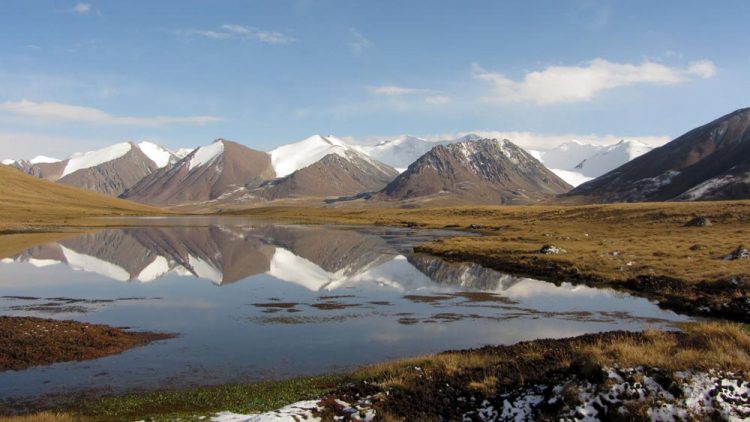Substantial glacier ice loss in Central Asia’s largest mountain range

A lake mirrors some fresh-snow covered glaciers in the Teskey Ala-Too, Kyrgyzstan. Yet the appearance is deceiving: Glaciers in the Tien Shan are losing mass at a rapid pace. (Photo: D. Farinotti, GFZ/WSL)
An international research team led by the GFZ German Research Centre for Geosciences and including the institute of the French Centre National de la Recherche Scientifique (CNRS) at Rennes University in particular, estimated that almost 3000 square kilometres of glaciers and an average of 5.4 gigatons of ice per year have been lost since the 1960s.
In the current online issue of Nature Geoscience, the authors estimate that about half of Tien Shan’s glacier volume could be depleted by the 2050s.
Glaciers play an important role in the water cycle of Central Asia. Snow and glacier melt from the Tien Shan is essential for the water supply of Kazakhstan, Kyrgyzstan, Uzbekistan, and parts of China.
“Despite this importance, only little was known about how glaciers in this region changed over the last century” the principal investigator Daniel Farinotti explains. Most of the direct monitoring programs, that were shut down with the collapse of the Soviet Union, are resumed only today, and modern observation techniques often cover a limited time span only.
GFZ-researcher Farinotti and colleagues now present a reconstruction of the glacier evolution in the Tien Shan. “We combined various methods based on satellite gravimetry, laser altimetry and glaciological modelling” Farinotti says. “This way, we were able to reconstruct the evolution of every single glacier. Currently, the Tien Shan is losing ice at a pace that is roughly twice the annual water consumption of entire Germany.”
Glaciers in Central Asia
Glaciers can store water as glacier ice over decades, and transfer winter precipitation into the summer months by releasing it as melt water. This is particularly important in seasonally arid regions, i.e. regions that have months with virtually no precipitation, since local water supply is then closely linked to meltwater availability.
Central Asia is the outstanding case for human dependence on water seasonally delayed by glaciers. Nowhere the question about the glacier state is linked so closely to questions of water availability and, thus, food security.
The pace of glacier retreat noticeably accelerated between the 1970s and the 1980s. Daniel Farinotti: “The long-term signal is clearly related to the overall rise in temperature”. In fact, the study shows that the rise in temperature, and summer temperature in particular, is a primary control for glacier evolution in the region.
“For Central Asia, this statement is less trivial than it might seem at first glance: Since the winter months in the region are very dry and the mountains are that high, glaciers receive most of their snowfalls during summer.” Farinotti explains. “This means that an increased temperature contributes to both, increased melt and reduced glacier nourishment – and obviously, both contributes to glacier wastage.”
By using the latest climate projections, which anticipate an additional 2 °C warming of summer temperatures in the period 2021 – 2050, the authors also provide a first outlook for the future evolution: Half of the total glacier ice volume present in the Tien Shan today could be lost by the 2050s.
Daniel Farinotti, Laurent Longuevergne, Geir Moholdt, Doris Duethmann, Thomas Mölg, Tobias Bolch, Sergiy Vorogushyn, and Andreas Güntner: “Substantial glacier mass loss in the Tien Shan over the past 50 years”, Nature Geoscience, Advance Online Publication, 17.08.2015, DOI: 10.1038/ngeo2513
Photos in a printable resolution may be found here:
Fig 1: http://tinyurl.com/q4um95h
Glaciological field measurements on a glacier in the Jetim-Bel range, Kyrgyzstan. Systematic in-situ surveys as pictured are essential for providing ground truth data against which satellite observation can be compared. (Photo: D. Farinotti, GFZ/WSL)
Fig 2: http://tinyurl.com/qd4xgly
Two unnamed glaciers in the Chrebet Terskey range, Kyrgyzstan. The topographic control on glacier occurrence is striking: North-facing slopes are glacierized, whilst south-facing slopes are free of ice. (Photo: D. Farinotti, GFZ/WSL)
Fig 3: http://tinyurl.com/o45v539
North facing slope of the Jetim-Bel range, Kyrgyzstan. Glacier melt is an essential water resource in an otherwise dry environment. (Photo: D. Farinotti, GFZ/WSL)
Fig 4: http://tinyurl.com/pdv3h3l
A lake mirrors some fresh-snow covered glaciers in the Teskey Ala-Too, Kyrgyzstan. Yet the appearance is deceiving: Glaciers in the Tien Shan are losing mass at a rapid pace. (Photo: D. Farinotti, GFZ/WSL)
Media Contact
More Information:
http://www.gfz-potsdam.de/All latest news from the category: Earth Sciences
Earth Sciences (also referred to as Geosciences), which deals with basic issues surrounding our planet, plays a vital role in the area of energy and raw materials supply.
Earth Sciences comprises subjects such as geology, geography, geological informatics, paleontology, mineralogy, petrography, crystallography, geophysics, geodesy, glaciology, cartography, photogrammetry, meteorology and seismology, early-warning systems, earthquake research and polar research.
Newest articles

Silicon Carbide Innovation Alliance to drive industrial-scale semiconductor work
Known for its ability to withstand extreme environments and high voltages, silicon carbide (SiC) is a semiconducting material made up of silicon and carbon atoms arranged into crystals that is…

New SPECT/CT technique shows impressive biomarker identification
…offers increased access for prostate cancer patients. A novel SPECT/CT acquisition method can accurately detect radiopharmaceutical biodistribution in a convenient manner for prostate cancer patients, opening the door for more…

How 3D printers can give robots a soft touch
Soft skin coverings and touch sensors have emerged as a promising feature for robots that are both safer and more intuitive for human interaction, but they are expensive and difficult…




















